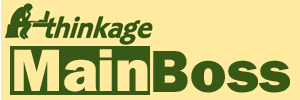What's New in MainBoss 3.3
The following lists changes between MainBoss Advanced 3.3 and the previous release.
Major Changes
- Requests, work orders, and purchase orders now have a user-definable "Status" field. For example, you might set up status codes to indicate when a work order is waiting for approval, waiting for parts, waiting for sign-off, and so on.
-
MainBoss now has the ability to send out e-mail notifications to
assignees of requests, work orders, and purchase orders.
In order to use this facility, you need to license the MainBoss Service module,
formerly called @Requests Service.
Notifications are mailed out whenever requests are put "in progress" and whenever work orders or purchase orders are opened. Notifications are also mailed out whenever someone adds a comment to an in-progress request or an open work order or purchase order. Notifications are not sent when requests, work orders or purchase orders are in the draft or closed state.
In order for an assignee to receive e-mail notifications, you must checkmark the Receive Notifications checkbox in the assignee record (either Requests | Assignees, Work Orders | Assignees, or Purchase Orders | Assignees).
This change is intended to help people use work order comments as a means of communication between each other. Instead of sending e-mail directly to other people involved with a work order, you can add a comment to the work order; MainBoss will then use e-mail to send your comment to everyone else assigned to the work order (provided they're allowed to receive e-mail notifications). Since work order comments are retained in the work order's history, MainBoss will preserve a record of all communications associated with the work order, which may be important in making sure you remember exactly what happened during the job. - All workers mentioned in a work order's inside or outside labor demands are considered assigned to the work order, provided they appear in the Work Order Assignees table and their assignee record has Receive Notifications checkmarked. Therefore, when the work order is opened, and whenever anyone creates a history record by using Add Work Order Comment, all assigned workers automatically receive a notification by e-mail. In other words, MainBoss automatically sends e-mail to workers, informing them that they've been assigned to a work order and providing updates on any comments added to the work order.
- All table viewers can now be filtered. This means that you can restrict what the table shows. For example, you might restrict the Work Orders table so that you only see work orders whose "Work Start Date" is today. Using filters lets you limit what you see in order to find information faster. Filters are set up using similar criteria to the existing Search facilities.
-
Use of the term "Active" (seen in the bottom right-hand corner of table viewers) has been expanded.
Previously, "Active" showed all records that hadn't been explicitly deleted.
Now, you can set things up so that old requests, work orders, and purchase orders
aren't included in the "Active" display.
This shortens your tables so that you can find the records you want more quickly.
By default, printed reports take into consideration your definition of "Active" and only print information from active records. If you want to see information from all records, go to the Advanced section of the window for printing reports and checkmark the box Suppress Active Filter restrictions. This tells MainBoss to print all records, not just active ones. (Suppress Active Filter restrictions replaces the old Show deleted records checkbox.)
Minor Changes
- When you selected a record in a table viewer, previous versions of MainBoss always displayed the contents of that record in a panel below the main record list. There is now a button that gets rid of this panel, leaving more room for the record list. This will be particularly helpful if you are using MainBoss through a computer with a small monitor screen.
- Many fields have a drop-down list, a "..." button, and a drop-down menu. In previous versions, only a small number of actions appeared in the drop-down menu and in the window associated with the "..." button. The number of actions has now been substantially increased. For example, if a field lists work orders, the drop-down menu and the "..." window let you close the work order, add comments to it, and much more.
- Tasks now let you specify a "Generate Lead Time". This is intended for jobs that need a special lead-time for some reason; for example, you might want to know about a PM job two weeks in advance so that you have time to order special parts or make arrangements to take important equipment offline. Thus if a task specifies a "Generate Lead Time" of 7 (days), work orders based on that task will be generated a week earlier than normal. The "Work Start Date" field in the generated work orders will give the date that the job should actually start.
- Facilities for searching tables have been modified to allow more flexibility.
-
Location and unit records now have a "Map Coordinates" field that lets you specify
exactly where the location or unit is.
Coordinates may be specified in longitude and latitude, or with a Google Maps URL
centered on the location or unit.
Any window showing a location or unit record also has a "Show on Map" button. If you click this button, MainBoss attempts to open Google Maps to a map showing the appropriate place. (In order for this to work, you must have a working Internet connection and a web browser.) - If you have licensed the Web Request module, the web page for submitting requests now has a "Where" field. Users can use this to provide information that will help workers find the problem. Note that this field doesn't have to be the name of a MainBoss unit—users outside the maintenance department probably don't know the "official" names of MainBoss units. The "Where" field is just a simple way for users to tell you where a problem is.
-
The process for working with work orders, purchase orders and outside labor has
been simplified.
Now, you can follow these steps:
- On the work order, create a demand for the outside labor.
- Click "New PO Line". This lets you create a purchase order entry corresponding to the demand (either on a new purchase order or in a purchase order already associated with this work order). An entry describing the purchase order line appears immediately below the demand.
- When the work is finished, click the purchase order line and then click "Actualize". MainBoss opens a window where you can actualize the demand and also "receive" the associated purchase order entry.
-
There are several new table viewers:
- Requests | In Progress | In Progress Requests without Work Orders shows requests that are "In Progress" but do not have any work orders linked to them. You might view these as requests that have been accepted by the maintenance department, but haven't yet led to a work order.
- Requests | In Progress | In Progress Requests with Work Orders shows requests that are "In Progress" and also have linked work orders. You might view these as requests on which you have actually taken action. (In earlier versions of MainBoss, these requests were called "transferred".)
- Items | Restocking shows similar information to the Restocking Report, but as a table rather than a report. The table shows items that need to be restocked in some storeroom. If the same item is available in another storeroom, the other storeroom is listed too. In this case, the table provides a "New Item Transfer" button that makes it easy to transfer items to the storeroom that needs to be restocked. There is also a "New Purchase Order" button that lets you create a purchase order to re-order the item.
-
Several new reports have been added:
- Requests | Reports | Status Statistics provides information about how long a request spent in each state or status. There are comparable reports for work orders and purchase orders.
- Unit Maintenance Plans | Reports | Maintenance Forecast Report predicts when work orders will be carried out (both corrective and planned).
- Purchase Orders | Reports | State History provides information about changes in state and status of individual purchase orders.
- The Work Orders | Closed table viewer now has a "Closing Code" column heading, allowing you to sort the list by closing code.
- In previous releases, a number of windows for printing reports had checkboxes in the Advanced section that allowed you to select what would and wouldn't be displayed in the report. In this release, the facility has been extended to many more reports.
- In previous releases, when you clicked Unit Maintenance Plans | Reports | Labor Forecast Report, you were immediately asked to specify a time period that the report would cover. In this release, you specify the time period in the Filtering section of the report printing window. The same applies to Unit Maintenance Plans | Reports | Material Forecast Report.
- In previous releases, you could not change the cost center associated with a storage assignment. Now you can do so, provided that the value of storage assignment is zero. You can also now change the storeroom associated with a storeroom assignment record.
-
Expense categories may now be restricted to certain uses only.
For example, you can specify that an expense category may be used for item expenses
but not for labor expenses or miscellaneous expenses.
This lets you prevent the use of a particular expense category for
an inappropriate purpose.
To restrict the uses of an existing expense category, open the expense category
record and adjust the checkmarks on the checkboxes "Item Expense Class", "Labor
Expense Class", and "Miscellaneous Expense Class".
When you upgrade a database made with a previous version of MainBoss, all existing expense categories are marked as valid for all purposes. We recommend that you review your expense categories and blank out any checkboxes that are inappropriate. For example, if you have an expense category that you use for labor expenses and only labor expenses, you should blank out "Item Expense Class" and "Miscellaneous Expense Class" in the expense category record. From this point forward, MainBoss will make sure that you don't use that expense category inappropriately. - In previous releases, you could void a work order, even if it had actual expenses associated with it. This is no longer possible; you can close the work order but not void it. (If you really want to void the work order, use corrections to set all the actual expenses to zero. Once there are no non-zero actual expenses, the work order can be voided.)
- Work order expense models now have a field that lets you specify a default expense category for miscellaneous expenses.
- When using MainBossRemote to add comments to a request or work order, the button that lets you save your comment have changed from "Add Comment" to "Save Comment".
- The "..." and drop-down menus for "Default" fields in an expense model now let you create expense mappings instead of expense categories. (Creating new expense categories isn't really helpful when defining a new expense model.)
-
Several new security roles have been introduced to provide administrators with greater
control over who can do what; other roles have been adjusted in response.
In particular, WorkOrderFulfillment now only lets you actualize demands and add comments to the work order; it does not let you close the work order. To close work orders, you need the WorkOrderClose security role. (This change was made for organizations which want to permit workers to actualize demands but which only want managers to close work orders.)
RequestFulfillment and PurchaseOrderFulfillment have been changed in a similar way—they no longer let you close requests and/or purchase orders (respectively). You now need the new RequestClose and/or PurchaseOrderClose security roles to perform close operations. - The format of the E-mail Requests section in a request record has changed to show information more clearly.
- The Administration | @Requests control panel entry has been renamed MainBoss Service. This is because the associated service software has been expanded to deal with notifications as well as emailed requests.
- Features for controlling MainBoss Service are now directly provided in Administration | MainBoss Service. For example, you can start and stop the service from this window. The window also lets you pause the service temporarily using the "Pause Service" button. (To uninstall the service, you use the normal Windows Control Panel and uninstall "MainBoss Service" like any other piece of software.)
- "Create New Organization from Backup" now demands that you specify a name that is not used by any existing database.
- In previous versions, the username under which MainBoss Service ran had to be included in the Users Table, thereby using up one of the "slots" covered by your MainBoss license. This is no longer necessary.
- In previous versions of MainBoss, the organization name associated with a database was case-sensitive; you could have one organization called "MyOrganization" and a different one called "myorganization". This is no longer true—if you try to assign a database a new organization name that is the same as another database except for the case of letters, MainBoss will give you an error message. (However, if you already have two databases whose organization names differ only in the case of letters, you can continue to use those names without receiving an error.)
Whats new in the preceding release MainBoss 3.2 Update 2
Whats new in the following release MainBoss 3.3 Update 1
The current release is MainBoss 4.2 Update 4




